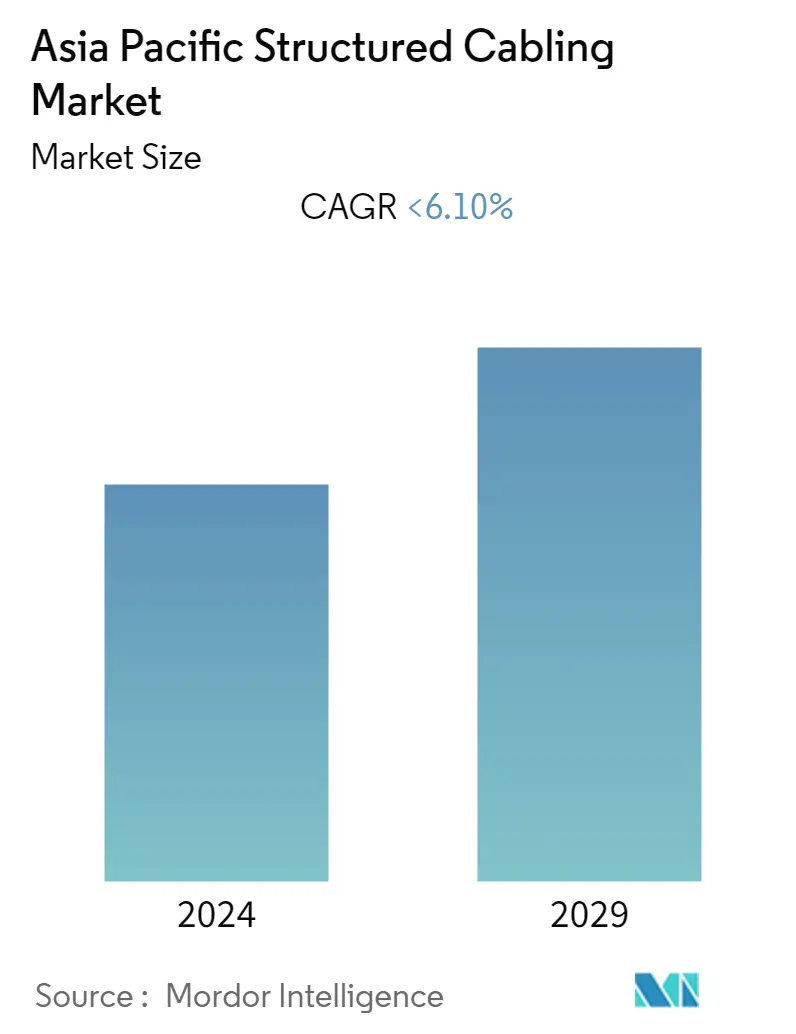Market Size of Asia Pacific Structured Cabling Industry

| Study Period | 2019 - 2029 |
| Base Year For Estimation | 2023 |
| Forecast Data Period | 2024 - 2029 |
| Historical Data Period | 2019 - 2022 |
| CAGR | < 6.10 % |
| Market Concentration | Low |
Major Players
*Disclaimer: Major Players sorted in no particular order |
Need a report that reflects how COVID-19 has impacted this market and its growth?
APAC Structured Cabling Market Analysis
The Asia Pacific Structured Cabling Market is expected to register a CAGR of approximately 6.1% over the forecast period. The growth of the structured cabling market in the Asia Pacific region is driven by several factors, including increasing consumption and decreasing the cost of Internet bandwidth, growth in the number of domestic companies hosting their critical applications, such as enterprise resource planning (ERP) and customer relationship management (CRM) in third-party data centers.
- Structured cabling is a commonly used tactic of using network cabling in the most streamlined, effective manner possible. It has become a valuable way to keep the cables organized and efficient. The structured cabling concept has become so crucial that other non-IT applications, such as building automation services, security, and high-definition audiovisual, have incorporated the same image to ensure that end devices can be upgraded or changed without having to change out the entire cabling infrastructure.
- Each of the significant cabling standards groups, namely ISO/IEC, TIA, and CENELEC, established standards for structured cabling in commercial offices, data centers, campuses, and more. These standards help specify the types of cabling and components used in these environments, including fiber and copper cabling.
- Fiber optic cabling is favored by businesses in long-distance telecommunication platforms, especially when a company needs a high-speed data connection. As fiber cabling provides an optimized, highly sustainable, and future-proof quality service as a broadband access technology, the increasing demand is driving innovations in the form of new product launches in the region. For instance, in October 2022, STL launched India's first multicore fiber and cable to support high capacity per 5G cell site, quantum communication feasibility, and Quad-core fiber connectivity in data centers.
- The increasing investment by governments in Asia pacific region to develop the fiber cable infrastructure is expected to create a favorable growth scenario for the studied market. For instance, under the NBM, the government of India has set a target of 70% liberalisation to take the country's fiber footprint to 5.5 million kilometers by 2024. To expedite the work, the Indian government has decided to lay fiber cables along all upcoming Greenfield and Brownfield expressway corridors. The fiber cables project will first be carried out on a pilot basis on Delhi-Mumbai and Hyderabad-Bengaluru expressways.
- A similar trend has been observed across other countries as well. For instance, in June 2022, the Japanese government stated that the government is aiming to bring high-speed fiber-optic networks to 99.9% of households before the fiscal year 2028 end, to ensure not just major cities but also regional areas can have smooth access to digital services in everyday life. Such advancements and innovations contribute to the studied market's growth.
- However, structured cabling involves various types of fiber optic components such as optics, transmitters, receivers, panels, and connectors, which are usually costly, resulting in higher installation costs. They are also susceptible to transmission losses which impact overall efficiency. Hence, these are among the major factors challenging the studied market's growth.
- The structured cabling market faced significant delays, particularly in the region, where the outbreak of COVID-19 forced the government to impose strict lockdown, especially during the initial phase, bringing down investments in new projects. However, the pandemic has underlined the critical role of data centers in ensuring that IT companies function and the daily lives of ordinary users, which is expected to support the growth of the studied market in the Asia Pacific region in the coming years.
